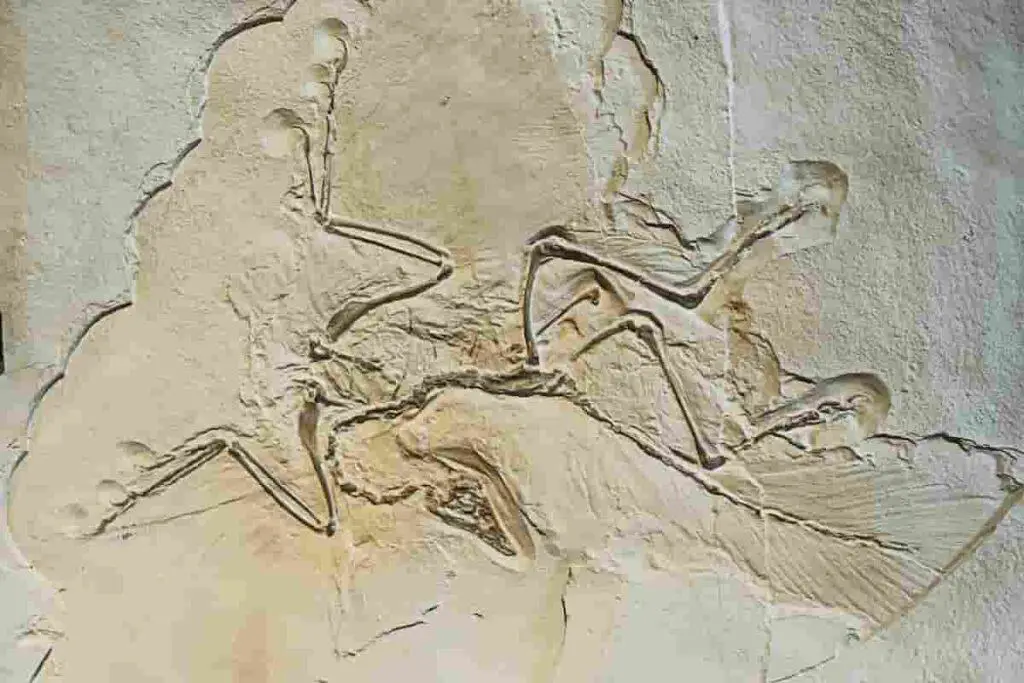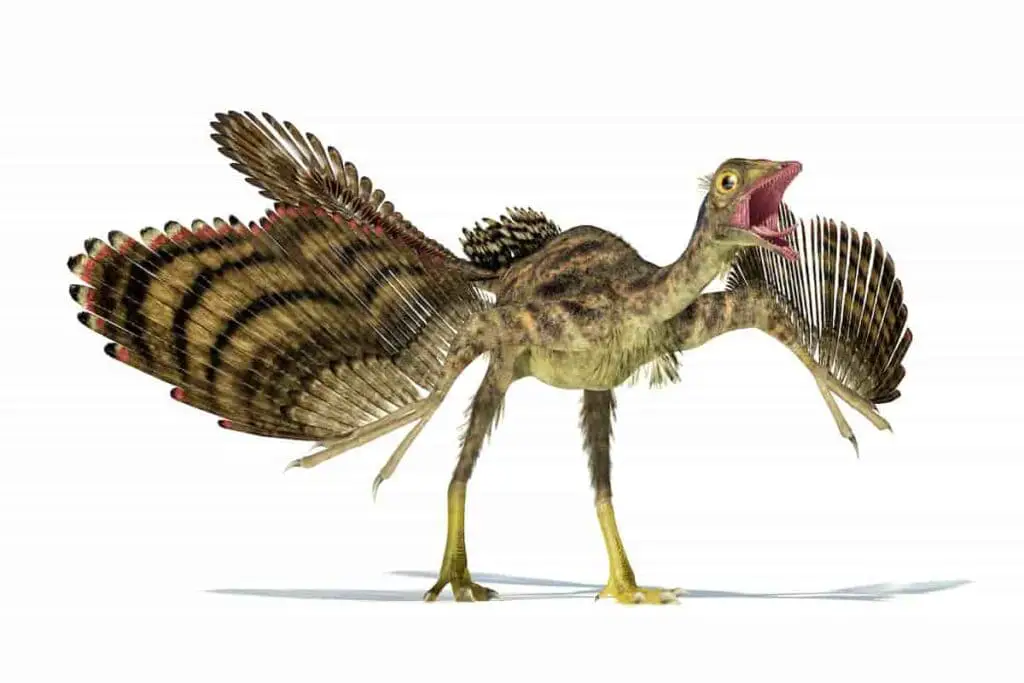Is Archaeopteryx a Pterosaur? This question often flutters into the minds of paleontology enthusiasts, tickling their curiosity as they gaze upon the feathered silhouette of what is popularly dubbed the ‘Urvogel.’ Imagine a creature, draped with wings, etching its place in the annals of prehistoric life, a bridge between the scaled and the feathered. The term ‘pterosaur’ conjures images of ancient reptilian gliders, wing lizards that once sliced through the Mesozoic skies. And there, in the corner of this prehistoric tapestry, is Archaeopteryx, with its own wings unfurled. Could this iconic fossil, which has long intrigued scientists and dreamers alike, belong to the same lineage as those majestic winged reptiles?

Is Archaeopteryx A Pterosaur?
The Archaeopteryx, despite looking like a pterosaur, is technically a theropod. It is fascinating considering that the Archaeopteryx shares more lineage with the T. Rex than it does the Pterodactyl.
Table of Contents
In today’s article, we’ll more closely examine the Archaeopteryx and compare it to pterosaurs so you can see what the differences are between the dinosaurs in that clade and the dino species known as the “first bird.” You won’t want to miss it!
How Scientists Classify the Archaeopteryx and the Pterosaur
Since dinosaurs don’t exist anymore to study, we can only go by their fossils, and the classifications scientists have created.
However, the thing about these classifications is that they’re rarely set in stone. As new dinosaur fossils and remains are uncovered, sometimes dinosaurs are reclassified.
That said, in this section, we’ll use the most current classification systems of dinosaurs available to determine how Archaeopteryx differs from pterosaurs.
Pterosaur Classification
Let’s begin by talking about pterosaurs. As we touched on, the dinosaurs with a Greek name that translates to “wing lizard” were part of their clade known as the Pterosauria.
Pterosaurs had air-filled, hollow bones as seen in today’s birds. The bones allowed for a muscle attachment surface that was higher than average. Thin bone walls are another characteristic that kept the body of pterosaurs lighter to allow for flight.
The breastbone supported muscles that activated flight, and even the brain of a pterosaur was more complex than most dinosaurs so it could fly successfully.
The backbone of pterosaurs fused into the dinosaur’s shoulders, becoming what’s called a notarium, but this is only true of some pterosaurs.
For the most part, pterosaurs were big dinosaurs, with an average wingspan of no less than 10 inches but often 30 feet or more. Some of the biggest pterosaurs were the size of today’s giraffes.
The skull of a pterosaur was bigger than average, with a long jaw and rather heterodont teeth but evolved into conical teeth later. Head crests were common.
Most pterosaurs had between 30 and 70 spinal vertebrae in their vertebral column. It undoubtedly supported their rather long necks. A pterosaur’s abdomen, by comparison, was usually very abbreviated.
Across a pterosaur’s body were pycnofibers, which are filaments akin to hair, almost like mammalian hair but not quite. The fibers allowed for thermoregulation so the pterosaurs could retain body heat.
Experts clearly differentiate that pycnofibers are not feathers but are similar to them.
Archeopteryx Classification
Now let’s take a closer look at Archeopteryx. This dinosaur’s Greek name translates to “wing” and “ancient,” both of which are fitting. Paleontologists have revered the Archeopteryx as one of the oldest bird-like creatures besides the Aurornis, Xiaotingia, and the Anchiornis. (Source)
Like troodontids and dromaeosaurids, the Archeopteryx had feathers, flexible second toes (known as killing claws), three clawed fingers, and pointy teeth.
And yes, it’s believed that the Archeopteryx had true-blue feathers. That’s something we’ll talk more about in the next section.

When Charles Darwin investigated the Archeopteryx as it was known then, he believed that the dinosaur was a bird. In the late 1970s, it was assumed to be a pterosaur. In 2013, a cladogram put the Archeopteryx among the Avialae clade with species like the Shenzhouraptor and Balaur.
Avialae, if you don’t know, includes birds, but it also has theropods. Thus, this is probably the most accurate classification of the Archeopteryx we have.
After all, the Archeopteryx is indeed a theropod and likely a part of the coelurosaurs. These diverse dinosaurs from the Cretaceous Period included dromaeosaurids such as the Deinonychus and Velociraptor, which share a lot of common traits with the Archeopteryx.
The tyrannosaurids are also in the coelurosaur group and the confirmed family that the Tyrannosaurus belongs to.
Feathers and Flight Abilities
Next, let’s compare the wings of the Archaeopteryx and pterosaurs in both looks and ability.
Feathers vs. Pycnofibers
As promised, it’s time to discuss Archaeopteryx’s feathers.
Up to 11 different Archaeopteryx fossils have visible feather impressions. The feathers are believed to be flight feathers, which are different than insulating feathers for warmth. A flight feather has an asymmetric shape. It’s also long and stiff.
You can see flight feathers today in many bird species. The purpose of flight feathers is to lift and thrust the bird forward when in flight.
The flight feathers of the Archeopteryx are indeed feathers as you know them. As seen in pterosaurs, Pycnofibers are more like hair than feathers, just to reiterate.
Here’s an interesting fact: the first piece of the frustrating but fascinating Archaeopteryx puzzle was a feather. The feather was uncovered in the early 1860s by Hermann von Meyer, a paleontologist. Meyer was also the one who incorrectly assumed that Archeopteryx was a pterosaur.
Up until 2020, the veracity of the feather as belonging to the Archaeopteryx was heavily debated among scientists and paleontologists. In 2020, advances in morphology confirmed that the feather belonged to an Archaeopteryx and not another dinosaur.
Archaeopteryx vs. Pterosaur Wingspans
As you should recall from earlier, the pterosaurs that roamed the earth between the Triassic and Cretaceous Periods were massive creatures. Some were about the size of a modern giraffe.
For clarity’s sake, a giraffe is between 14 and 18 feet high, so they’re massive animals.
We haven’t talked about Archaeopteryx’s size yet. This dinosaur was very small, only about the size of a modern-day crow. Compare a crow to a giraffe and bigger pterosaurs outsized the Archaeopteryx hundreds of times.
When it comes to wingspan, you can imagine that it’s a non-contest. Even the smallest pterosaurs had a wingspan of at least 10 inches, while larger ones had a wingspan of 30 feet or so. It far outshines the wingspan of the Archaeopteryx. (Source)
That was a very modest two-foot wingspan, which is about 60 centimeters. Not bad for a dinosaur about the size of a crow, but not much to write home about either.
Here is a list of pterosaurs with tremendous wingspans so that you can see how much more massive these wingspans were:
- Tupuxuara longicristatus – 20 feet
- Pteranodon longiceps – 20.5 feet
- Thapunngaka shawi – 23 feet
- Moganopterus zhuiana – 23 feet
- Geosternbergia maysei – 24 feet
- Tropeognathus mesembrinus – 27 feet
- Cryodrakon boreas – 33 feet
- Quetzalcoatlus northropi – 33 to 36 feet
- Hatzegopteryx thambema – 36 to 39 feet
- Arambourgiania philadelphiae – 23 to 43 feet

Characteristics That Link the Archaeopteryx to Birds
To be clear, pterosaurs are not birds, and neither was the Archaeopteryx. That said, birds are considered today’s living dinosaurs for a reason.
Parrots and emus are akin in ways to the Utahraptor, a theropod. Even chickens, eagles, and falcons share traits with the Archeopteryx. As you should know if you read this blog, chickens are a T. Rex relative.
Why is this so? Depending on the species, birds have evolved differently over time. Keeping that in mind, here are some traits of the Archeopteryx that link it to birds.
Size
Birds come in various sizes, as small as five inches and as large as 72 inches. The Archaeopteryx is sized similarly to small birds.
Feathers
It is a big linking characteristic. Pterosaurs had filaments, whereas Archaeopteryx had feathers like those that today’s living birds possess. As we established, the Archaeopteryx used these feathers for flight, but we’ll talk more about its flight abilities in just a moment.
Flight
While Archaeopteryx could fly, it seems that modern birds would outpace this dinosaur by quite a huge margin. The reason? The shoulder or glenoid joint of the Archaeopteryx was sideways in relation to the humerus, coracoid, and scapula. Today’s birds have a dorsal glenoid joint.
This joint positioning might have prevented Archaeopteryx from raising its wings over its back. Upstroking would have been impossible then. More than likely, the Archaeopteryx could only handle downstroke flying and mostly gliding rather than flapping.
Then again, the dinosaur just as easily could have had its unique flight stroke pattern that we just don’t know enough about yet.
If Archaeopteryx’s flight methods were efficient, today’s birds would have likely had a sideways-angled glenoid joint as well how the Archaeopteryx flew sufficed at the time but has since been improved upon through evolution. (Source)
Conclusion
The Archaeopteryx is a confounding specimen. It’s not a pterosaur, nor is it a bird. That’s true, even though this dinosaur had feathers and could fly. The Archaeopteryx is instead a theropod like a T. Rex.
As much information as we have on the Archaeopteryx, there’s still plenty more to learn!
